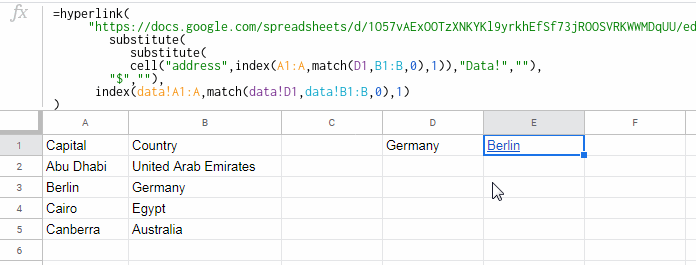Google Sheets supports creating a hyperlink to an Index-Match output cell. The output value returned (the Index-Match result) can be turned into a clickable hyperlink within the spreadsheet.
Please note: the row or column argument in INDEX should not be 0, as that can result in multiple values being returned—something not supported when creating a hyperlink.
In short, based on this tutorial, you can only hyperlink to a single-cell output of an Index-Match formula in Google Sheets.
Purpose
The purpose of this tutorial is to demonstrate how to create a Hyperlink Index-Match in Google Sheets—i.e., make the result of an INDEX-MATCH formula clickable, pointing to the source cell.

How to Hyperlink to Index-Match Result in Google Sheets
I’m using a very simple table so that you can easily recreate it for testing the formula. It contains the names of a few countries and their national capitals.
| National Capital | Country Names |
| Abu Dhabi | United Arab Emirates |
| Berlin | Germany |
| Cairo | Egypt |
| Canberra | Australia |
Create the above table in the range A1:B5 and rename the sheet as 'data'. (You can use any sheet name, but using 'data' helps you follow along easily.)
Then follow the steps below to create a Hyperlink Index-Match result in Google Sheets.
Step 1: Index-Match Formula
I know many of you already use INDEX-MATCH, but I’m walking through it to keep this tutorial beginner-friendly.
Example:
We want to match “Germany” in column B and return the corresponding value from column A—“Berlin”.
Type "Germany" in cell D1, then use the following MATCH formula in E1:
=MATCH(Data!D1, Data!B1:B, 0)This returns 3, meaning we need to offset 3 rows in column A.
Next, use the INDEX function:
=INDEX(Data!A1:A, 3, 1)Now combine both functions:
=INDEX(Data!A1:A, MATCH(Data!D1, Data!B1:B, 0), 1)This formula returns "Berlin"—the capital of Germany.

Step 2: Get the Cell Address of the Index-Match Result
Since INDEX returns a value, not a cell reference, we use the CELL function to get the cell address of the result.
Generic syntax:
=CELL("address", index-match_formula)Applied formula in cell E2:
=CELL("address", INDEX(Data!A1:A, MATCH(Data!D1, Data!B1:B, 0), 1))This returns the absolute reference (e.g., $A$3 or data!$A$3).
Let’s remove the dollar signs and sheet name using nested SUBSTITUTE functions. Use this revised formula in cell E2:
=SUBSTITUTE(
SUBSTITUTE(
CELL("address", INDEX(Data!A1:A, MATCH(Data!D1, Data!B1:B, 0), 1)), "data!", ""
),"$",""
)The result will be A3.
Step 3: Copy and Edit the Cell URL
To create a clickable link to the INDEX-MATCH result, we need a full URL pointing to the exact cell.
- Right-click on cell
A1in the'data'sheet. - Click View more cell actions > Get link to this cell.
- Paste the copied link into cell
E3.
Example link (you must use your actual URL):
https://docs.google.com/spreadsheets/d/****#gid=92***9&range=A1
Edit the link to remove the specific cell (e.g., A1) at the end so the link ends with:
...&range=
Step 4: Create the Hyperlink to the Index-Match Output
The HYPERLINK function uses the syntax:
HYPERLINK(URL, [link_label])- URL: The full spreadsheet link (step 3) plus the cell address (step 2).
- link_label: The
INDEX-MATCHresult (step 1).
Final Formula:
=HYPERLINK(
"https://docs.google.com/spreadsheets/d/****#gid=92***9&range=" &
SUBSTITUTE(
SUBSTITUTE(
CELL("address", INDEX(Data!A1:A, MATCH(Data!D1, Data!B1:B, 0), 1)), "data!", ""
),"$",""
),
INDEX(Data!A1:A, MATCH(Data!D1, Data!B1:B, 0), 1)
)Now delete the helper formulas in cells E1, E2, and E3, and use this final formula in cell E1. Voila! You’ve created a Hyperlink Index-Match in Google Sheets.
Hyperlink Index-Match in Google Sheets
This is a practical method to dynamically hyperlink Index-Match results. It helps users jump to the relevant data cell directly, streamlining navigation in large spreadsheets.
Resources
- Hyperlink to VLOOKUP Result in Google Sheets (Dynamic Link)
- Search for a Value and Hyperlink the Found Cell in Google Sheets
- Hyperlink Max and Min Values in Column or Row in Google Sheets
- How to Label URL in Google Sheets Using HYPERLINK Function
- UNIQUE Duplicate Hyperlinks in Google Sheets – Same Labels, Different URLs
- Case-Sensitive Reverse VLOOKUP Using Index-Match in Google Sheets
- Multiple Conditions in Index-Match in Google Sheets




















Can I index match from another google sheet and do the same functions?
Hi, Midhun,
It’s not possible. But there is a workaround that I will post soon! Please stay tuned for my upcoming post.
Could you show a file with an example? Thank you!!
Hi, Mario,
Thanks for letting me know. Added the link button at the end of the post.